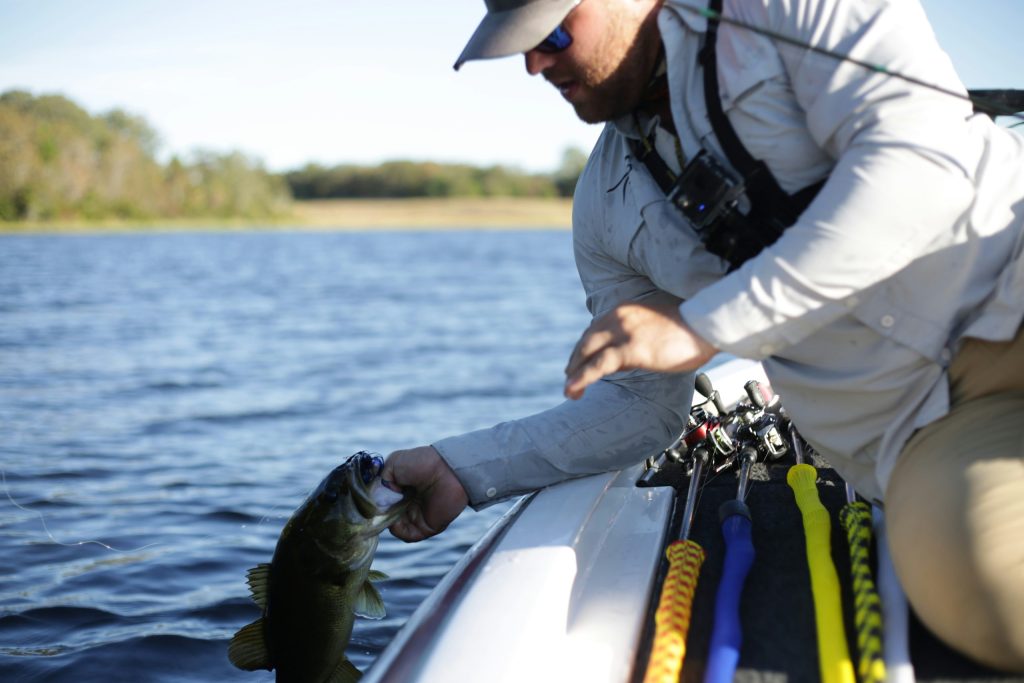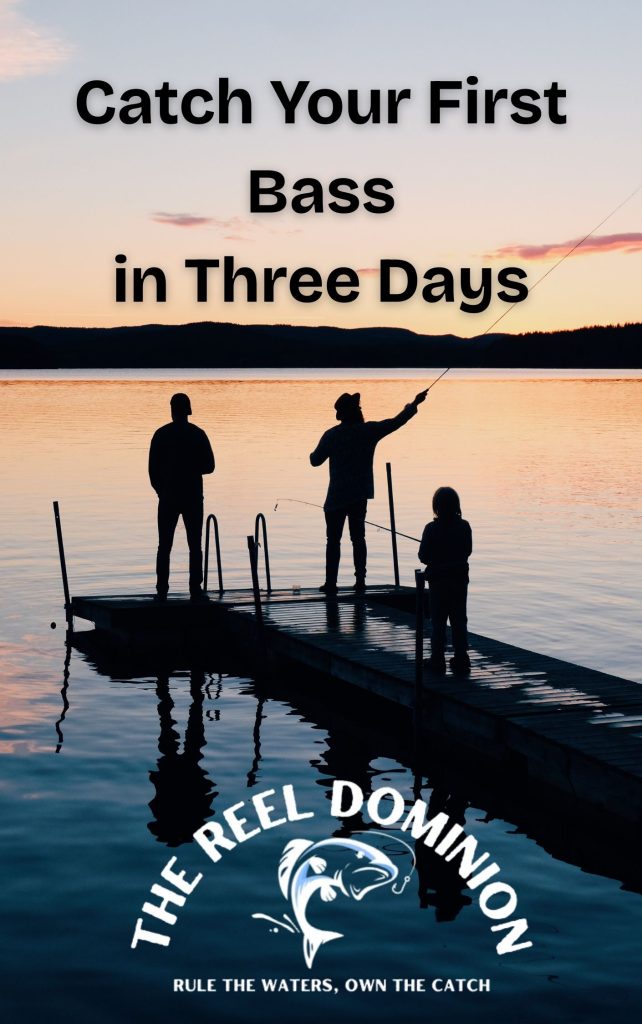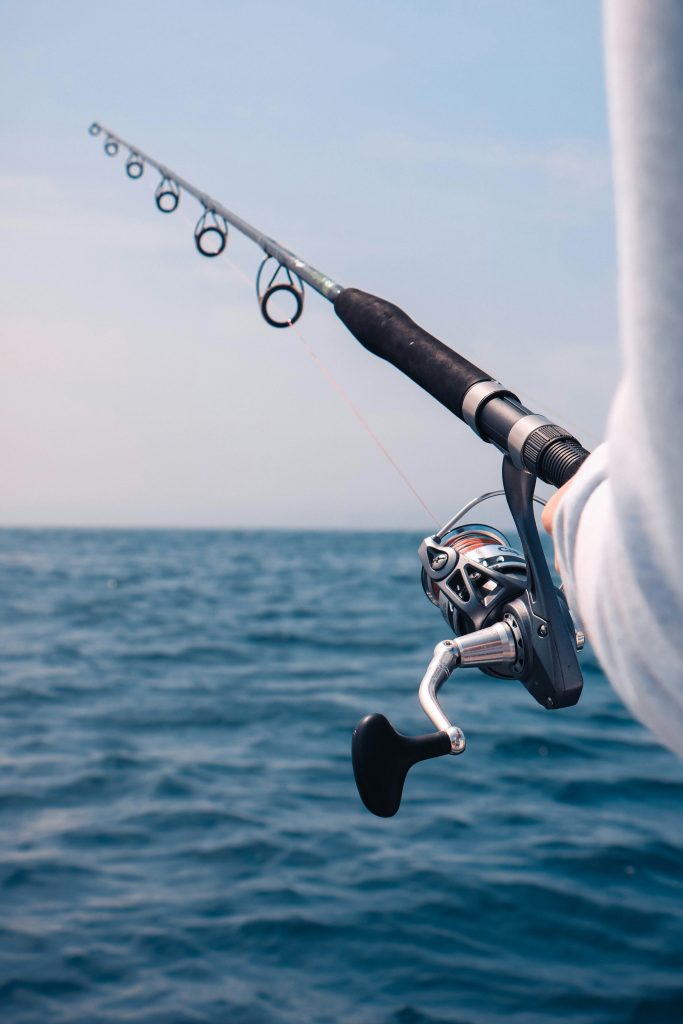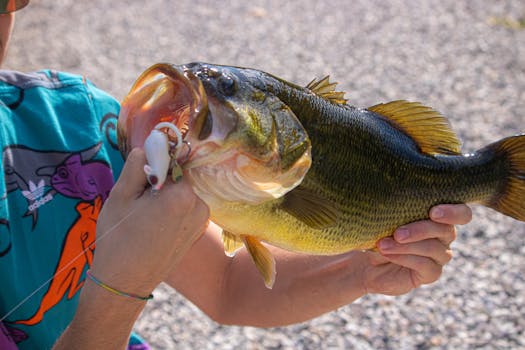
- Why Bass Fishing Is the Perfect Hobby for Beginners
- Essential Gear for Beginners: Build Your Bass Fishing Setup the Right Way
- Proven Bass Fishing Rigs: Master the Basics to Maximize Your Catch
- Seasonal Strategies for Bass Fishing For Beginners: Mastering Year-Round Success
- Common Bass Fishing Mistakes and How to Avoid Them
- Best Locations for Bass Fishing in the U.S.
- Your Next Cast Starts Here
Disclosure: This post may contain affiliate links. If you purchase through these links, I may earn a small commission at no extra cost to you. As an Amazon Associate, I earn from qualifying purchases.
Why Bass Fishing Is the Perfect Hobby for Beginners
If you’re new to the sport, bass fishing for beginners is one of the easiest — and most rewarding — ways to get started. It doesn’t require a boat, it won’t break your budget, and the learning curve is far gentler than other styles of angling. In fact, according to the U.S. Fish & Wildlife Service, black bass (including largemouth and smallmouth) are the most commonly targeted freshwater species in the United States, with 9.4 million anglers fishing for them each year (USFWS National Survey of Fishing, Hunting, and Wildlife-Associated Recreation, 2016).
Why the massive appeal? Simple: bass are aggressive feeders, relatively easy to locate, and thrive in a wide variety of freshwater environments. From rural ponds to urban reservoirs, bass are widespread, making access easy for those without a boat or expensive equipment. This is exactly why beginner bass fishing is often the recommended entry point for people of all ages.
Better still, research by the Recreational Boating & Fishing Foundation shows that fishing improves emotional well-being, reduces stress, and encourages physical activity — making it more than just a pastime. For first-timers, that means the right setup for bass fishing for beginners isn’t just a ticket to your first catch — it’s a gateway to better health, more time outdoors, and a new lifelong hobby.
If you’re new and want to catch fish without wasting time or money, this step-by-step guide (and my downloadable eBook) shows you exactly what to use, when to fish, and how to start catching bass confidently — even with zero experience.

Essential Gear for Beginners: Build Your Bass Fishing Setup the Right Way
Starting with the right equipment is crucial. Here’s a breakdown of essential gear:
For a versatile setup for bass fishing for beginners, a medium-action spinning rod paired with a compatible reel offers adaptability across various fishing conditions. This combination provides a balance between sensitivity and power, making it suitable for different techniques and environments. Looking for the best fishing rods for beginners? We’ve got you covered!
Rod and Reel: Your Core Setup
Recommended Combos:
St. Croix GXR Spinning Combo: Known for its lightweight and sensitive carbon-fiber construction, it’s ideal for finesse fishing.
Abu Garcia Max Elite Spinning Combo: Offers excellent value with a smooth-operating reel and durable rod, suitable for various bass fishing techniques.
Zebco 33 Spincast Combo: A classic choice for beginners, featuring simplicity and ease of use.
Line: Monofilament for Ease and Versatility
Monofilament lines are recommended for beginners due to their ease of use and knot strength. They offer good shock absorption and are forgiving, making them ideal for learning.
Top Picks:
Berkley Trilene XL: Known for its smooth casting and versatility across various fishing situations.
Stren Original: Offers reliable performance with good knot strength and abrasion resistance.
Hooks and Weights: Ensuring Effective Bait Presentation
Selecting appropriate hook sizes and weights ensures better bait presentation and increases catch rates. For beginners, using a variety of hooks and weights can help adapt to different fishing conditions.
Essential Components:
- Hooks: Start with sizes 2 to 4 offset worm hooks, suitable for various soft plastic baits.
- Weights: Use 1/8 to 1/4-ounce bullet weights for Texas rigs, allowing for effective bottom fishing.
Investing in quality gear not only enhances the fishing experience but also contributes to sustainable practices by reducing gear-related fish injuries.
Ready to gear up and catch your first bass? Download our comprehensive bass fishing for beginners eBook, “The Beginner’s Guide to Bass Fishing,” for detailed gear recommendations, rig setups, and expert tips to start your fishing journey with confidence.
Proven Bass Fishing Rigs: Master the Basics to Maximize Your Catch
When it comes to rigs for bass fishing for beginners, understanding and mastering a few foundational setups can significantly increase your success rate. These rigs are time-tested, effective, and adaptable to various fishing conditions. Check out the 10 most popular lures and how to use them effectively.
Texas Rig: Versatility and Weedless Design
The Texas rig is a staple in setups for bass fishing for beginners due to its simplicity and effectiveness. It consists of a bullet-shaped weight, an offset worm hook, and a soft plastic bait. The design allows the bait to move naturally while minimizing snags, making it ideal for fishing in heavy cover.
Key Benefits:
- Weedless presentation allows fishing in dense vegetation.
- Suitable for various soft plastic baits.
- Effective in both shallow and deep waters.
Usage Tips:
- Use a medium-heavy rod with a fast action tip.
- Pair with a 10-15 lb fluorocarbon line for sensitivity.
- Ideal for targeting bass hiding in structures like logs and rocks.
Carolina Rig: Covering Ground Efficiently
The Carolina rig is excellent for covering large areas and locating bass in deeper waters. It features a heavy sinker fixed above a swivel, a leader line, and a hook with soft plastic bait. This setup allows the bait to move freely, enticing bass that are spread out or in deeper zones.
Key Benefits:
- Effective for deep-water fishing.
- Covers more ground, helping locate scattered bass.
- Ideal for fishing over sandy or rocky bottoms.
Usage Tips:
- Use a 7-foot medium-heavy rod for longer casts.
- Pair with a 12-20 lb monofilament or fluorocarbon line.
- Drag the rig slowly along the bottom to mimic natural prey movement.
Drop Shot Rig: Precision for Finicky Bass
The Drop Shot rig is a finesse technique perfect for targeting bass that are less aggressive or suspended in the water column. It involves a hook tied directly to the line with a weight at the end, allowing the bait to hover above the bottom.
Key Benefits:
- Highly effective in clear water conditions.
- Allows precise bait placement.
- Ideal for vertical presentations and targeting suspended bass.
Usage Tips:
- Use a light spinning rod with a 6-10 lb fluorocarbon line.
- Opt for small, soft plastic baits like worms or minnows.
- Gently twitch the rod tip to impart subtle movements to the bait.
Mastering these rigs for bass fishing for beginners will provide a solid foundation for your angling adventures. Each rig offers unique advantages, and understanding when and how to use them will enhance your effectiveness on the water.
Want detailed diagrams and step-by-step instructions? Download our comprehensive eBook, “The Beginner’s Guide to Bass Fishing,” to elevate your fishing skills and confidence.

Seasonal Strategies for Bass Fishing For Beginners: Mastering Year-Round Success
Understanding seasonal patterns is crucial for any angler aiming to improve their catch rates. This section provides tips for bass fishing for beginners, focusing on how bass behavior changes throughout the year and how to adapt your strategies accordingly.
Spring: Pre-Spawn and Spawning Behavior
In spring, rising water temperatures trigger bass to move into shallow areas to spawn. This period offers excellent opportunities for anglers.
Key Strategies:
- Target Shallow Flats: Bass congregate in shallow, warm areas. Using rigs for bass fishing for beginners like the Texas rig can be effective here.
- Use Soft Plastics: Lures that mimic prey, such as soft plastic worms or lizards, are particularly effective during this time.
- Fish During Warmest Part of Day: Bass are more active as water temperatures rise.
Starting in spring? Our spring guide covers seasonal bass habits and winning tactics.
Summer: Deep Water and Shade
As temperatures increase, bass often retreat to deeper waters or seek shade to stay cool.
Key Strategies:
- Fish Early or Late: Bass are more active during cooler parts of the day.
- Target Deep Structures: Use rigs for bass fishing for beginners like the Carolina rig to reach deeper areas where bass may be hiding.
- Utilize Topwater Lures: During early morning or late evening, topwater lures can entice bass feeding near the surface.
Fall: Feeding Frenzy
In preparation for winter, bass feed aggressively in the fall, making it an excellent time for anglers.
Key Strategies:
- Use Moving Baits: Crankbaits and spinnerbaits can cover water quickly and trigger reaction strikes.
- Focus on Baitfish Imitations: Lures that mimic shad or other baitfish are particularly effective.
- Fish Midday: Bass may be more active during the warmer parts of the day as temperatures begin to drop.
Winter: Slow and Steady
Bass metabolism slows in colder temperatures, making them less active and more challenging to catch.
Key Strategies:
- Fish Slowly: Use slow-moving lures and techniques to entice sluggish bass.
- Target Deep Holes: Bass often gather in deeper areas during winter.
- Use Smaller Lures: Downsizing your bait can be more appealing to less active fish.
By understanding and adapting to these seasonal patterns, beginners can significantly improve their bass fishing success.
Common Bass Fishing Mistakes and How to Avoid Them
When you’re new to bass fishing for beginners, it’s easy to make avoidable errors that cost you time, money, and missed catches. But with the right knowledge—and a bit of science-backed strategy—you can skip the learning curve and start fishing smarter.
Below are the most common mistakes beginners make, and what you should do instead to improve your results from day one.
Mistake 1: Using the Wrong Gear
A common issue for beginners is choosing equipment that doesn’t match their fishing conditions or skill level. For example, heavy baitcasting rods and high-test braided lines are overkill in calm, clear lakes and often frustrate new anglers due to backlashes and poor casting distance.
What to do instead:
Use a medium-action spinning rod with monofilament line in the 6–10 lb test range. It’s more forgiving, easier to cast, and ideal for learning basic rigs like the Texas rig or Carolina rig.
– This setup is highlighted in our downloadable eBook as part of the setup for “bass fishing for beginners” chapter.
Mistake 2: Ignoring Water Temperature and Seasonal Changes
Bass are cold-blooded animals, and their activity levels are highly influenced by water temperature. A 2008 study from the Illinois Natural History Survey found that largemouth bass feeding rates dropped by over 50% when water temperatures fell below 50°F (Rogers et al., 2008).
What to do instead:
Check water temperatures and adjust your approach. In cold weather, slow your retrieve. In warm months, fish deeper or at dawn/dusk. If you’re not adjusting seasonally, you’re leaving fish in the water.
Mistake 3: Fishing at the Wrong Time of Day
Many beginners fish mid-day when the sun is high and bass are inactive. According to the Florida Fish and Wildlife Conservation Commission (2022), bass are most active in low-light conditions—especially early morning and late afternoon.
What to do instead:
Plan your trips around sunrise or sunset, when bass are cruising shallows looking for food. These “bite windows” drastically increase your chances of success.
Mistake 4: Overworking Your Lure
Aggressive lure movement might spook bass, especially in pressured waters. Research by the Missouri Department of Conservation suggests that bass in high-pressure areas are more likely to strike subtle, natural presentations than erratic or noisy lures. Want a deep dive into bass lures? Here’s the ultimate lure guide.
What to do instead:
Focus on finesse presentations—soft plastics, natural colors, and slower retrieves. Let the fish come to you.
Mistake 5: Not Learning Local Regulations
Overlooking fishing regulations (like size limits or restricted gear types) not only risks fines—it also contributes to unsustainable fishing practices. Each U.S. state publishes detailed rules; for example, see Texas Parks & Wildlife Regulations for bass-specific guidance.
What to do instead:
Download the regulations for your state, and check for seasonal closures, minimum size requirements, or bait restrictions.
Best Locations for Bass Fishing in the U.S.
For beginners eager to experience top-tier bass fishing, the United States offers a plethora of renowned lakes and rivers teeming with largemouth and smallmouth bass. These prime locations not only provide abundant fishing opportunities but also cater to various skill levels, making them ideal for novices.
1. O.H. Ivie Lake, Texas
Situated in central Texas, O.H. Ivie Lake has garnered acclaim for producing trophy-sized largemouth bass. In early 2025, a notable catch of a 14.05-pound bass was recorded, underscoring the lake’s reputation. The Texas Parks and Wildlife Department’s Toyota ShareLunker program frequently highlights this reservoir for its contribution to bass genetics and fisheries management.
2. St. Lawrence River (Thousand Islands), New York
Renowned for its smallmouth bass population, the St. Lawrence River offers a unique fishing experience. In a 2023 Bassmaster Elite Series tournament, anglers reported impressive catches, with several exceeding 100 pounds over four days. This river remains a top destination for those seeking quality smallmouth bass fishing.
3. Lake Fork, Texas
Lake Fork stands out as a premier bass fishing destination, holding 15 of the top 20 Texas state record largemouth bass. Managed by the Sabine River Authority, the reservoir’s design and stocking strategies have made it a hotspot for anglers aiming for significant catches.
4. Clear Lake, California
As California’s largest natural freshwater lake, Clear Lake boasts a rich ecosystem supporting a thriving bass population. The lake’s abundant vegetation and baitfish make it a favorite among anglers seeking both quantity and quality in their catches.
5. Lake Guntersville, Alabama
Located along the Tennessee River, Lake Guntersville is Alabama’s largest lake and a renowned bass fishing destination. Its diverse habitats and consistent fishery management practices have solidified its status among top U.S. bass fishing locations.
Your Next Cast Starts Here
Embarking on your bass fishing journey is more than just a pastime—it’s an invitation to connect with nature, develop new skills, and experience the thrill of the catch. From understanding seasonal patterns to selecting the right gear and exploring top fishing locales, you’re now equipped with foundational knowledge to begin.
Remember, every expert angler started as a beginner. With patience, practice, and persistence, you’ll find yourself mastering techniques and reeling in impressive catches. Whether you’re casting from the shores of O.H. Ivie Lake or exploring the waters of the St. Lawrence River, opportunities abound.
To further enhance your skills and knowledge, consider downloading our comprehensive eBook, “Bass Fishing for Beginners: Tips, Rigs, and Setups You Need to Start Catching Today.” Packed with detailed guides, rig diagrams, and expert advice, it’s your go-to resource for advancing in the world of bass fishing.
Ready to make your next cast count? Get your copy of our Bass Fishing for Beginner’s eBook now and take the first step towards becoming a proficient bass angler.
Affiliate Disclosure: Some of the links in this article are affiliate links. This means that if you click on one of these links and make a purchase, I may receive a small commission. There is no additional cost to you. I only recommend products and services I trust and believe will add value to your bass fishing experience. As an Amazon Associate, I earn from qualifying purchases. Your support helps keep this site running—thank you!




Если нужно автоматизированное размещение ссылок, можно базы хрумера купить https://www.olx.ua/d/uk/obyavlenie/progon-hrumerom-dr-50-po-ahrefs-uvelichu-reyting-domena-IDXnHrG.html у проверенных поставщиков.
Спасибо за предложение, но, к сожалению, я предпочитаю развивать ссылки постепенно и органично, через контент и партнёрства. Для меня важнее долгосрочная стратегия SEO, чем автоматизированные методы. Удачи вам в работе!